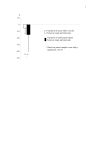Stride-to-stride variability while backward counting among healthy young adults
- PMID: 16095533
- PMCID: PMC1190208
- DOI: 10.1186/1743-0003-2-26
Stride-to-stride variability while backward counting among healthy young adults
Abstract
Background: Little information exists about the involvement of attention in the control of gait rhythmicity. Variability of both stride time and stride length is closely related to the control of the rhythmic stepping mechanism. We sought 1) to determine whether backward counting while walking could provoke significant gait changes in mean values and coefficients of variation of stride velocity, stride time and stride length among healthy young adults; and 2) to establish whether change in stride-to-stride variability could be related to dual-task related stride velocity change, attention, or both.
Methods: Mean values and coefficients of variation of stride velocity, stride time and stride length were recorded using the Physilog-system, at a self-selected walking speed in 49 healthy young adults (mean age 24.1 +/- 2.8 years, women 49%) while walking alone and walking with simultaneous backward counting. Performance on backward counting was evaluated by recording the number of figures counted while sitting alone and while walking.
Results: Compared with walking alone, a significant dual-task-related decrease was found for the mean values of stride velocity (p < 0.001), along with a small but significant increase for the mean values and coefficients of variation of stride time (p < 0.001 and p = 0.015, respectively). Stride length parameters did not change significantly between both walking conditions. Dual-task-related increase of coefficient of variation of stride time was explained by changing stride velocity and variability between subjects but not by backward counting. The number of figures counted while walking decreased significantly compared to backward counting alone. Further, the dual-task related decrease of the number of enumerated figures was significantly higher than the dual-task related decrease of stride velocity (p = 0.013).
Conclusion: The observed performance-changes in gait and backward counting while dual tasking confirm that certain aspects of walking are attention-demanding in young adults. In the tested group of 49 young volunteers, dual tasking caused a small decrease in stride velocity and a slight increase in the stride-to-stride variability of stride time, while stride velocity variability was not affected by the attention-demanding task. The increase in stride time variability was apparently the result of a change in gait speed, but not a result of dual tasking. This suggests that young adults require minimal attention for the control of the rhythmic stepping mechanism while walking.
Figures
Similar articles
-
Relationships between dual-task related changes in stride velocity and stride time variability in healthy older adults.Hum Mov Sci. 2006 Jun;25(3):372-82. doi: 10.1016/j.humov.2006.03.004. Epub 2006 May 22. Hum Mov Sci. 2006. PMID: 16714067
-
Stride-to-stride variability while enumerating animal names among healthy young adults: result of stride velocity or effect of attention-demanding task?Gait Posture. 2008 Jan;27(1):138-43. doi: 10.1016/j.gaitpost.2007.03.011. Epub 2007 Apr 27. Gait Posture. 2008. PMID: 17467275
-
Physical training-related changes in gait variability while single and dual tasking in older adults: magnitude of gait variability at baseline matters.Eur J Phys Rehabil Med. 2013 Dec;49(6):857-64. Epub 2013 Nov 28. Eur J Phys Rehabil Med. 2013. PMID: 24285023
-
[Gait and dual-task: definition, interest, and perspectives in the elderly].Psychol Neuropsychiatr Vieil. 2006 Sep;4(3):215-25. Psychol Neuropsychiatr Vieil. 2006. PMID: 16945851 Review. French.
-
Effects of experimentally induced fatigue on healthy older adults' gait: A systematic review.PLoS One. 2019 Dec 30;14(12):e0226939. doi: 10.1371/journal.pone.0226939. eCollection 2019. PLoS One. 2019. PMID: 31887182 Free PMC article.
Cited by
-
Effect of a vocal choice reaction time task on the kinematics of the first recovery step after a sudden underfoot perturbation during gait.Gait Posture. 2013 Jan;37(1):61-6. doi: 10.1016/j.gaitpost.2012.06.002. Epub 2012 Jul 12. Gait Posture. 2013. PMID: 22795474 Free PMC article.
-
Network-Based Transcranial Direct Current Stimulation May Modulate Gait Variability in Young Healthy Adults.Front Hum Neurosci. 2022 Jun 9;16:877241. doi: 10.3389/fnhum.2022.877241. eCollection 2022. Front Hum Neurosci. 2022. PMID: 35754767 Free PMC article.
-
Impact of distinct cognitive domains on gait variability in individuals with mild cognitive impairment and dementia.Exp Brain Res. 2024 Jul;242(7):1573-1581. doi: 10.1007/s00221-024-06832-9. Epub 2024 May 16. Exp Brain Res. 2024. PMID: 38753043 Free PMC article.
-
Neural Correlates of Dual-Task Walking: Effects of Cognitive versus Motor Interference in Young Adults.Neural Plast. 2016;2016:8032180. doi: 10.1155/2016/8032180. Epub 2016 Apr 20. Neural Plast. 2016. PMID: 27200192 Free PMC article.
-
Does the Presence of Cognitive Impairment Exacerbate the Risk of Falls in People with Peripheral Neuropathy? An Application of Body-Worn Inertial Sensors to Measure Gait Variability.Sensors (Basel). 2020 Feb 29;20(5):1328. doi: 10.3390/s20051328. Sensors (Basel). 2020. PMID: 32121396 Free PMC article.
References
-
- Gage WH, Sleik RJ, Polych MA, McKenzie NC, Brown LA. The allocation of attention during locomotion is altered by anxiety. Exp Brain Res. 2003;150:385–394. - PubMed
-
- Ebersbach G, Dimitrijevic MR, Poewe W. Influence of concurrent tasks on gait: a dual-task approach. Percept Mot Skills. 1995;81:107–113. - PubMed
LinkOut - more resources
Full Text Sources
Medical



